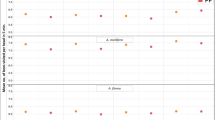Abstract
A first field study was conducted to investigate the possible adverse effects that seeds dressed with neonicotinoid insecticides pose to honeybees during sowing. It was observed that in the exposure hives bee mortality increased on the day of sowing and that the number of foraging bees decreased the days after the sowing. The corn sowing posed a significant threat to honeybees, with thiamethoxam being the most probable toxic agent. A theoretical contact exposure was calculated for a bee when flying over the sown fields, revealing a dose of 9.2 ng bee−1 close to the contact LD50 of thiamethoxam.

Similar content being viewed by others
References
Aliouane Y, El Hassani AK, Gary V, Armengaud C, Lambin M, Gauthier M (2009) Subchronic exposure of honeybees to sublethal doses of pesticides: effects on behaviour. Environ Toxicol Chem 28:113–122
Buckingham S, Lapied B, Corronc H, Sattelle F (1997) Imidacloprid actions on insect neuronal acetylcholine receptors. J Exp Biol 200:2685–2692
Colin ME, Bonmatin M, Moineau I, Gaimon C, Brun S, Vermandere JP (2004) A method to quantify and analyze the foraging activity of honey bees: relevance to the sublethal effects induced by systemic insecticides. Arch Environ Contam Toxicol 47:387–395
Decourtye A, Devillers J, Cluzeau S, Charreton M, Pham-Delègue M (2004) Effects of imidacloprid and deltamethrin on associative earning in honeybees under semi-field and laboratory conditions. Ecotox Environ Safe 57:410–419
el Hassani AK, Dacher M, Gary V, Lambin M, Gauthier M, Armengaud C (2008) Effects of sublethal doses of acetamiprid and thiamethoxam on the behaviour of the honeybee (Apis mellifera). Arch Environ Contam Toxicol 54:653–661
EU–European Commission, Health & Consumer Protection Directorate-General (2002) Review report for the active substance metalaxyl-M. SANCO/3037/99—final
EU–European Commission, Health & Consumer Protection Directorate-General (2007) Review report for the active substance fludioxonil. SANCO/2818/07—rev. 2
Ganzelmeier H, Rautmann D, Spangenberg R, Streloke M, Herrmann M, Wenzelburger H-J, Walter H-F (1995) Studies of the spray drift of plant protection products. Mittellungen aus der Biologischen Bundesanstalf für Land- und Forstwirtschaft. Berlin-Dahlem, H 305
Greatti M, Sabatini AG, Barbattini R, Rossi S, Stravisi A (2003) Risk of environmental contamination by the active ingredient imidacloprid used for corn seed dressing. Preliminary Results. Bull Insectol 56:69–72
Greatti M, Barbattini R, Stravisi A, Sabatini AG, Rossi S (2006) Presence of the a. i. imidacloprid on vegetation near corn fields sown with Gaucho® dressed seeds. Bull Insectology 59:99–103
Higes M, Martín-Hernández R, Garrido-Bailón E, González-Porto AV, García-Palencia P, Meana A, del Nozal MJ, Mayo R, Bernal JL (2009) Honeybee colony collapse due to Nosema ceranae in professional apiaries. Environ Microbiol Rep 1:110–113
Hileman B (2007) Why are the bees dying? Chem Eng News 85:56–61
Iwasa T, Motoyama N, Ambrose JT, Roe RM (2004) Mechanism for the differential toxicity of neonicotinoid insecticides in the honey bee, Apis mellifera. Crop Prot 23:371–378
Johnson RM, Pollock HS, Berenbaum MR (2009) Synergistic interactions between in-hive miticides in Apis mellifera. J Econ Entomol 102:474–479
Laszlo B (2008) About the uncommon bee losses. Literature review. Magy Allatorv Lapja 130:551–557
Le Conte Y, Navajas M (2008) Climate change: impact on honey bee population and diseases. Rev Sci Tech-OIE 27:499–510
Ribiere M, Olivier V, Blanchard P, Schurr F, Celle O, Drajnudel P, Faucon JP, Thiery R, Chauzat MP (2008) The collapse of bee colonies: the CCD case (‘Colony collapse disorder’) and the IAPV virus (Israeli acute paralysis virus). Virologie 12:319–322
Senn R, Hofer D, Hoppe T, Angst M, Wyss P, Brandl F, Maienfisch P (1998) CGA 293’343: a novel broad–spectrum insecticide supporting sustainable agriculture worldwide. Pest and diseases, vol 1. Brighton Crop Protection Conference, Brighton
vanEngelsdorp D, Underwood R, Caron D, Hayes J (2007) An estimate of managed colony losses in the winter of 2006–2007: a report commissioned by the apiary inspectors of America. Am Bee J 147:599–603
Author information
Authors and Affiliations
Corresponding author
Rights and permissions
About this article
Cite this article
Tremolada, P., Mazzoleni, M., Saliu, F. et al. Field Trial for Evaluating the Effects on Honeybees of Corn Sown Using Cruiser® and Celest xl® Treated Seeds. Bull Environ Contam Toxicol 85, 229–234 (2010). https://doi.org/10.1007/s00128-010-0066-1
Received:
Accepted:
Published:
Issue Date:
DOI: https://doi.org/10.1007/s00128-010-0066-1




